Unit 4: Management and Operations Assignment
VerifiedAdded on 2021/01/02
|14
|4075
|128
AI Summary
Contribute Materials
Your contribution can guide someone’s learning journey. Share your
documents today.
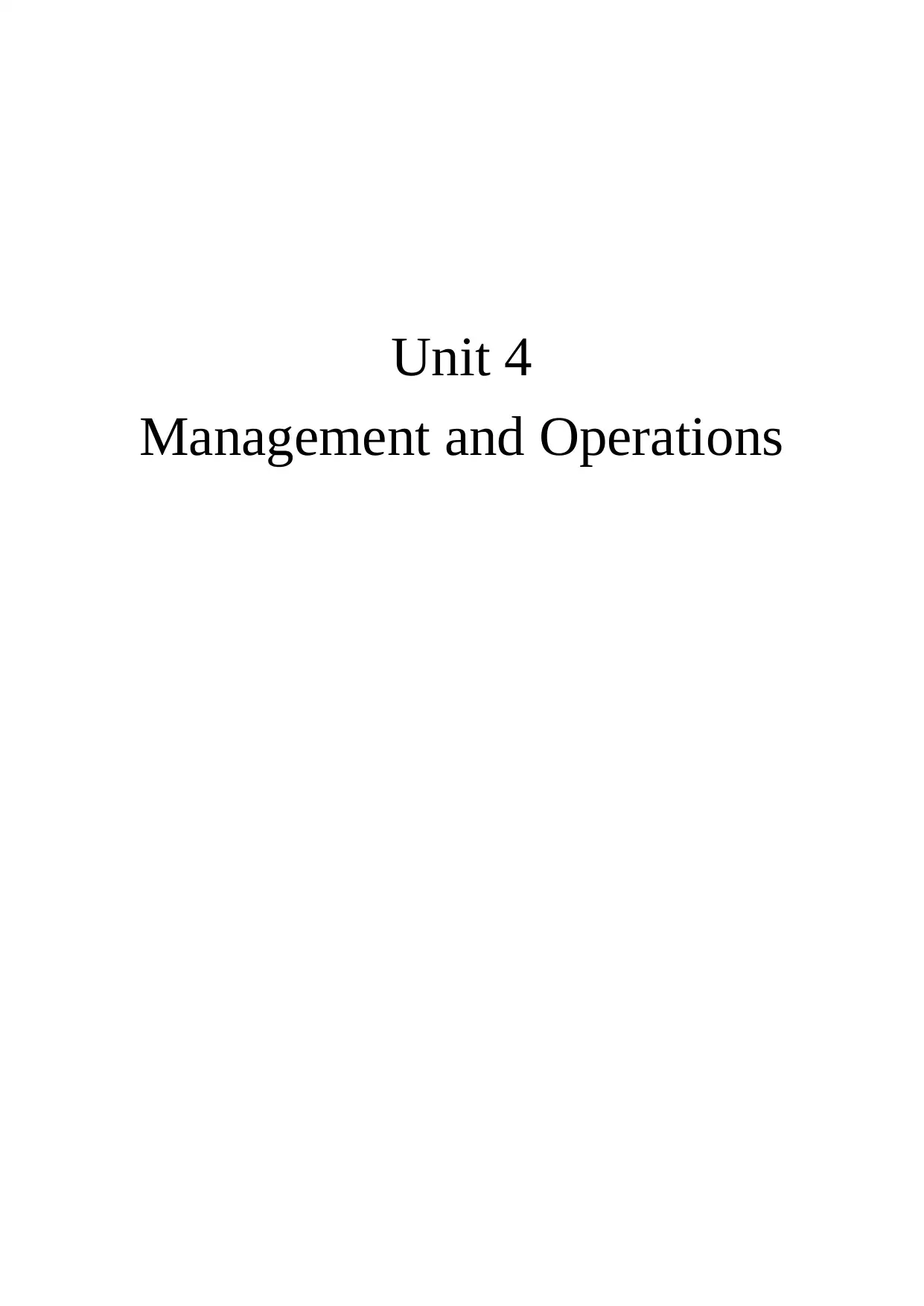
Unit 4
Management and Operations
Management and Operations
Secure Best Marks with AI Grader
Need help grading? Try our AI Grader for instant feedback on your assignments.

INTRODUCTION
In an organisation operation performs transformation of resources or data that inputs
desired goals and services in order to create value to customer's as well as organisation.
Where as management is define as activities or task that are undertaken for purpose of
achieving objectives and goals of an organisation. This report is going to analysis role of a
leader and function of managers in context or organisation. Moreover, applying different
theories and models of leadership and various approaches to operation management that help
in achieving business objectives of an organisation. Furthermore, understanding leadership
and management impact on organisation in decision making process.
LO1
P1
Leader
The leader is a person who inspires employees to improve their working method for fulfilling the
company's goal.
In an organisation operation performs transformation of resources or data that inputs
desired goals and services in order to create value to customer's as well as organisation.
Where as management is define as activities or task that are undertaken for purpose of
achieving objectives and goals of an organisation. This report is going to analysis role of a
leader and function of managers in context or organisation. Moreover, applying different
theories and models of leadership and various approaches to operation management that help
in achieving business objectives of an organisation. Furthermore, understanding leadership
and management impact on organisation in decision making process.
LO1
P1
Leader
The leader is a person who inspires employees to improve their working method for fulfilling the
company's goal.

Leaders are those people who want something, they can have it, they can get what they want because
they trust them, which leads to trusting those around him, to feel like they can. The leader has the
ability to induce people to do what he wants, to change their behaviour.
Characteristics of a leader
Characteristics of the leader are determined by originality, inspiration, visionary , ability to persuade
and communicate well etc.
Manager
The manager performs a domain-specific activity that corresponds to the profile of the organization
and hierarchical position that he occupies with psychological characteristics imposed by his
personality. Thus, the manager can be a model for some employees, adopts his own driving style,
develops a certain managerial culture
Characteristics
A manager must be a good teacher and know to be understood by his power to transmit.
they trust them, which leads to trusting those around him, to feel like they can. The leader has the
ability to induce people to do what he wants, to change their behaviour.
Characteristics of a leader
Characteristics of the leader are determined by originality, inspiration, visionary , ability to persuade
and communicate well etc.
Manager
The manager performs a domain-specific activity that corresponds to the profile of the organization
and hierarchical position that he occupies with psychological characteristics imposed by his
personality. Thus, the manager can be a model for some employees, adopts his own driving style,
develops a certain managerial culture
Characteristics
A manager must be a good teacher and know to be understood by his power to transmit.
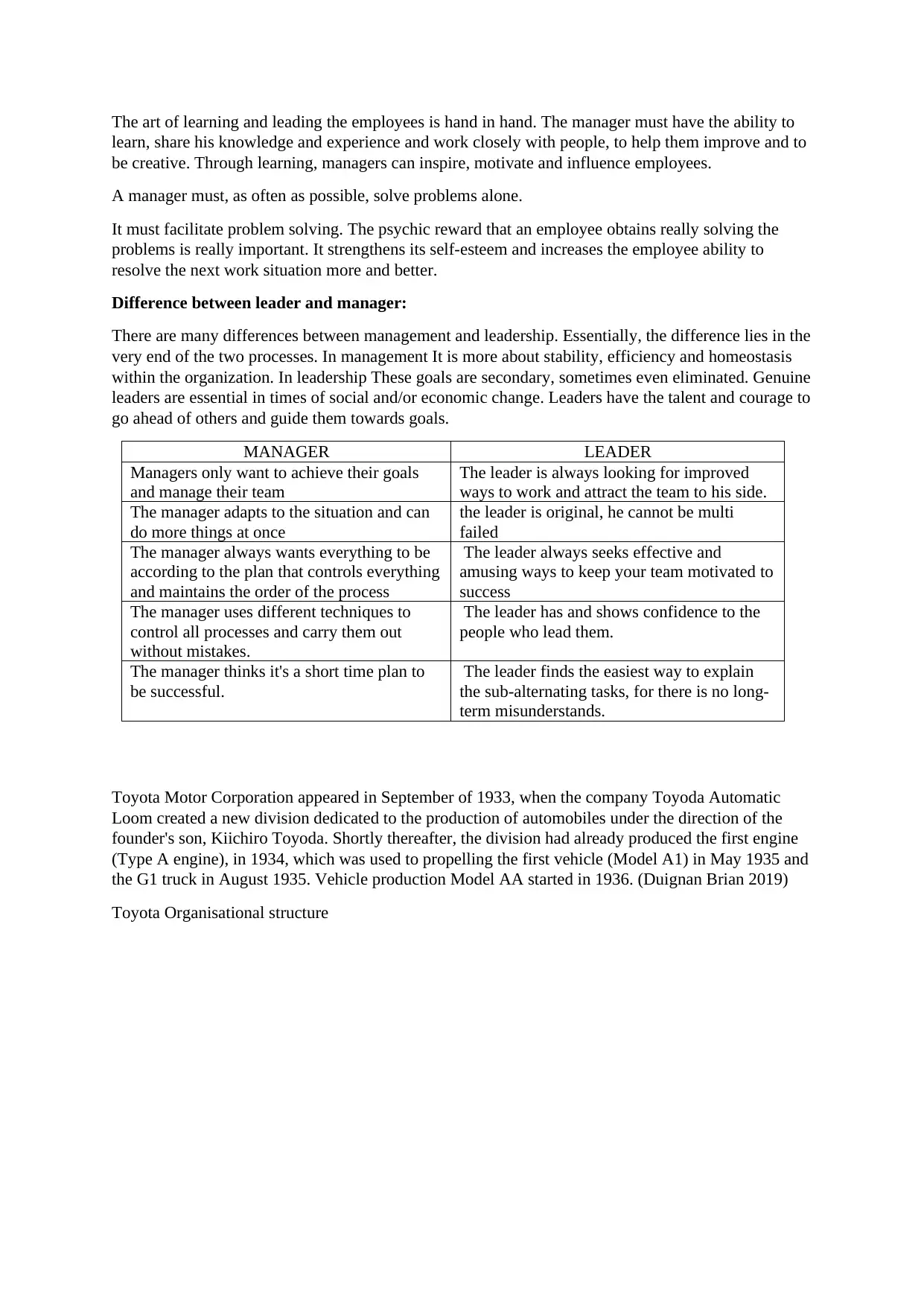
The art of learning and leading the employees is hand in hand. The manager must have the ability to
learn, share his knowledge and experience and work closely with people, to help them improve and to
be creative. Through learning, managers can inspire, motivate and influence employees.
A manager must, as often as possible, solve problems alone.
It must facilitate problem solving. The psychic reward that an employee obtains really solving the
problems is really important. It strengthens its self-esteem and increases the employee ability to
resolve the next work situation more and better.
Difference between leader and manager:
There are many differences between management and leadership. Essentially, the difference lies in the
very end of the two processes. In management It is more about stability, efficiency and homeostasis
within the organization. In leadership These goals are secondary, sometimes even eliminated. Genuine
leaders are essential in times of social and/or economic change. Leaders have the talent and courage to
go ahead of others and guide them towards goals.
MANAGER LEADER
Managers only want to achieve their goals
and manage their team
The leader is always looking for improved
ways to work and attract the team to his side.
The manager adapts to the situation and can
do more things at once
the leader is original, he cannot be multi
failed
The manager always wants everything to be
according to the plan that controls everything
and maintains the order of the process
The leader always seeks effective and
amusing ways to keep your team motivated to
success
The manager uses different techniques to
control all processes and carry them out
without mistakes.
The leader has and shows confidence to the
people who lead them.
The manager thinks it's a short time plan to
be successful.
The leader finds the easiest way to explain
the sub-alternating tasks, for there is no long-
term misunderstands.
Toyota Motor Corporation appeared in September of 1933, when the company Toyoda Automatic
Loom created a new division dedicated to the production of automobiles under the direction of the
founder's son, Kiichiro Toyoda. Shortly thereafter, the division had already produced the first engine
(Type A engine), in 1934, which was used to propelling the first vehicle (Model A1) in May 1935 and
the G1 truck in August 1935. Vehicle production Model AA started in 1936. (Duignan Brian 2019)
Toyota Organisational structure
learn, share his knowledge and experience and work closely with people, to help them improve and to
be creative. Through learning, managers can inspire, motivate and influence employees.
A manager must, as often as possible, solve problems alone.
It must facilitate problem solving. The psychic reward that an employee obtains really solving the
problems is really important. It strengthens its self-esteem and increases the employee ability to
resolve the next work situation more and better.
Difference between leader and manager:
There are many differences between management and leadership. Essentially, the difference lies in the
very end of the two processes. In management It is more about stability, efficiency and homeostasis
within the organization. In leadership These goals are secondary, sometimes even eliminated. Genuine
leaders are essential in times of social and/or economic change. Leaders have the talent and courage to
go ahead of others and guide them towards goals.
MANAGER LEADER
Managers only want to achieve their goals
and manage their team
The leader is always looking for improved
ways to work and attract the team to his side.
The manager adapts to the situation and can
do more things at once
the leader is original, he cannot be multi
failed
The manager always wants everything to be
according to the plan that controls everything
and maintains the order of the process
The leader always seeks effective and
amusing ways to keep your team motivated to
success
The manager uses different techniques to
control all processes and carry them out
without mistakes.
The leader has and shows confidence to the
people who lead them.
The manager thinks it's a short time plan to
be successful.
The leader finds the easiest way to explain
the sub-alternating tasks, for there is no long-
term misunderstands.
Toyota Motor Corporation appeared in September of 1933, when the company Toyoda Automatic
Loom created a new division dedicated to the production of automobiles under the direction of the
founder's son, Kiichiro Toyoda. Shortly thereafter, the division had already produced the first engine
(Type A engine), in 1934, which was used to propelling the first vehicle (Model A1) in May 1935 and
the G1 truck in August 1935. Vehicle production Model AA started in 1936. (Duignan Brian 2019)
Toyota Organisational structure
Secure Best Marks with AI Grader
Need help grading? Try our AI Grader for instant feedback on your assignments.
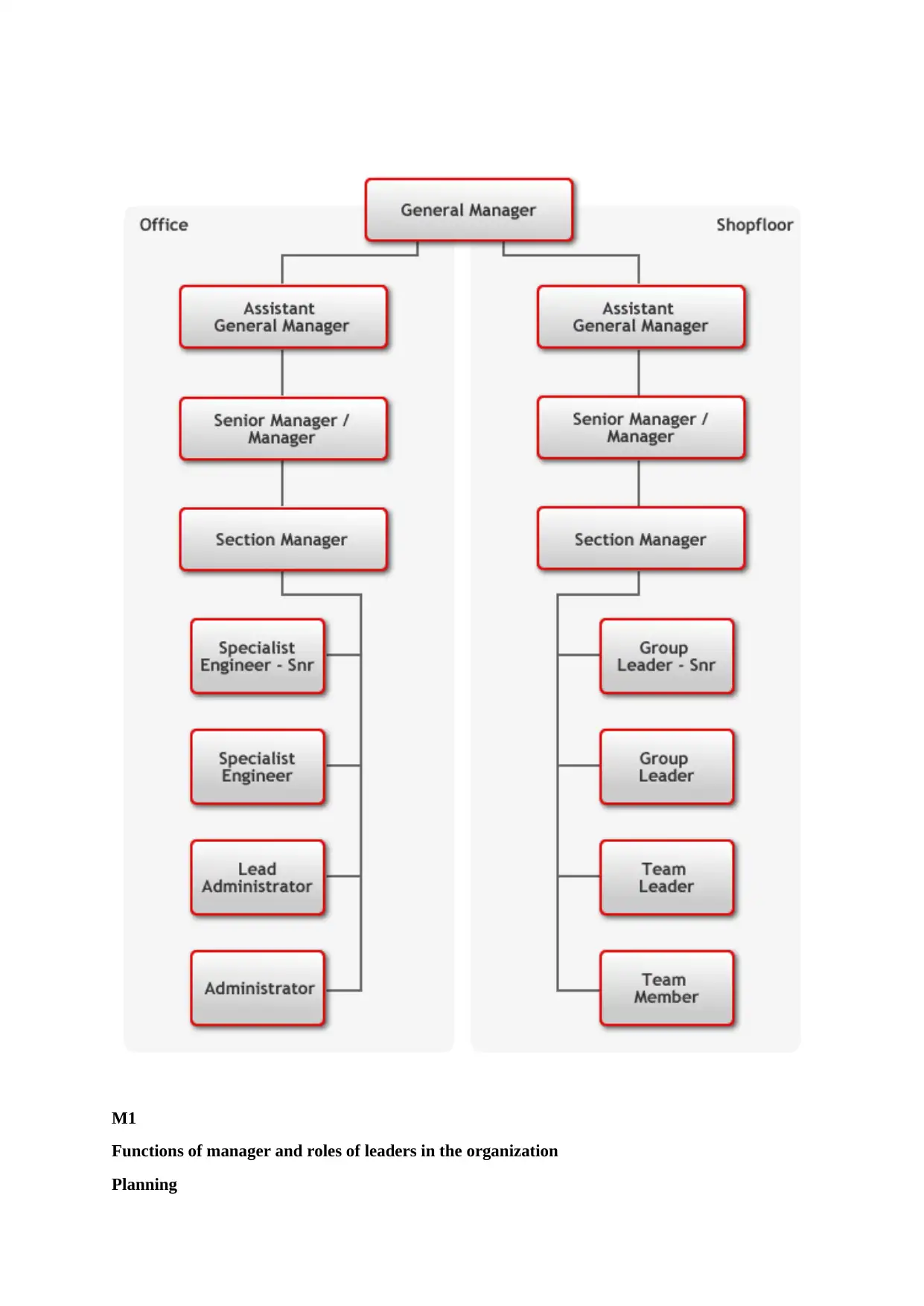
M1
Functions of manager and roles of leaders in the organization
Planning
Functions of manager and roles of leaders in the organization
Planning

Planning is the one that decides-in advance-what will be done, how it will be done, when it will be
done and who will do it. She is strongly involved in introducing the new "in the organization.
Through the elaborate plans, the managers offer the first, "tools" that help the company to be prepared
for any change that would be required by the environment in which it performs its activity.
The most important function of management in Toyota PLC is the decision-making activity. The
manager establishes the objectives and use the most appropriate strategies like Kaizen to achieve them
.
The role of leaders in Toyota PLC is to bring to the attention of the employees the roles set by the
manager and motivate them to focus on achieving the objectives.
Organizing
The purpose of the organizational structure is to allow the company's staff to obtain as many
performances as possible. The structure must define and cover the tasks to be fulfilled, to design the
rules of human relations. The determination of an organisational structure is a problem, not easy, for
management, because it needs to define the types of activations that need to delight as well as the staff
that can do them the best.
The manager of Toyota Plc , determinate the activities that advertise the fulfilment of the
objectives ,group the activities and their division into departments or wards ,delegate authority, where
appropriate, to achieve them. The role of leaders is to ensure that it has the appropriate methods and
that it is appropriate to motivate employees to give maximum results.
Directing
The managers create and give the tasks to be accomplished by the Toyota PLC employees, and they
inspire them to build the same vision.
Coordinating
The function of the Toyota PLC manager is to make a balance between individual or group interests
with the goals of the organization. Regardless of the type of organization (production, commercial,
financial, etc.), each individual interprets the company mode or good work. Thus, the Toyota PLC
manager must, bringing to the same denominator “the respective interpretations, placing them towards
the achievement of the basic objectives of the organisation. Leaders must create a harmony and
provide certain compensations and benefits to team members in the form of a transition to keep the
team motivated.
Controlling
The aim of the control is to maintain the balance to achieve the proposed goal. In reality, they not only
delight in the founding of an organization. As a rule, there are a multitude of combinations in their
pleasure. Years ago, some authors added staff function management.
Toyota PLC Manager must verify that the current performance of the company is compliant with the
planned one. This is achieved by the management control function, which advertises three elements:
Determination of the standard (limit, threshold) of performance;
done and who will do it. She is strongly involved in introducing the new "in the organization.
Through the elaborate plans, the managers offer the first, "tools" that help the company to be prepared
for any change that would be required by the environment in which it performs its activity.
The most important function of management in Toyota PLC is the decision-making activity. The
manager establishes the objectives and use the most appropriate strategies like Kaizen to achieve them
.
The role of leaders in Toyota PLC is to bring to the attention of the employees the roles set by the
manager and motivate them to focus on achieving the objectives.
Organizing
The purpose of the organizational structure is to allow the company's staff to obtain as many
performances as possible. The structure must define and cover the tasks to be fulfilled, to design the
rules of human relations. The determination of an organisational structure is a problem, not easy, for
management, because it needs to define the types of activations that need to delight as well as the staff
that can do them the best.
The manager of Toyota Plc , determinate the activities that advertise the fulfilment of the
objectives ,group the activities and their division into departments or wards ,delegate authority, where
appropriate, to achieve them. The role of leaders is to ensure that it has the appropriate methods and
that it is appropriate to motivate employees to give maximum results.
Directing
The managers create and give the tasks to be accomplished by the Toyota PLC employees, and they
inspire them to build the same vision.
Coordinating
The function of the Toyota PLC manager is to make a balance between individual or group interests
with the goals of the organization. Regardless of the type of organization (production, commercial,
financial, etc.), each individual interprets the company mode or good work. Thus, the Toyota PLC
manager must, bringing to the same denominator “the respective interpretations, placing them towards
the achievement of the basic objectives of the organisation. Leaders must create a harmony and
provide certain compensations and benefits to team members in the form of a transition to keep the
team motivated.
Controlling
The aim of the control is to maintain the balance to achieve the proposed goal. In reality, they not only
delight in the founding of an organization. As a rule, there are a multitude of combinations in their
pleasure. Years ago, some authors added staff function management.
Toyota PLC Manager must verify that the current performance of the company is compliant with the
planned one. This is achieved by the management control function, which advertises three elements:
Determination of the standard (limit, threshold) of performance;
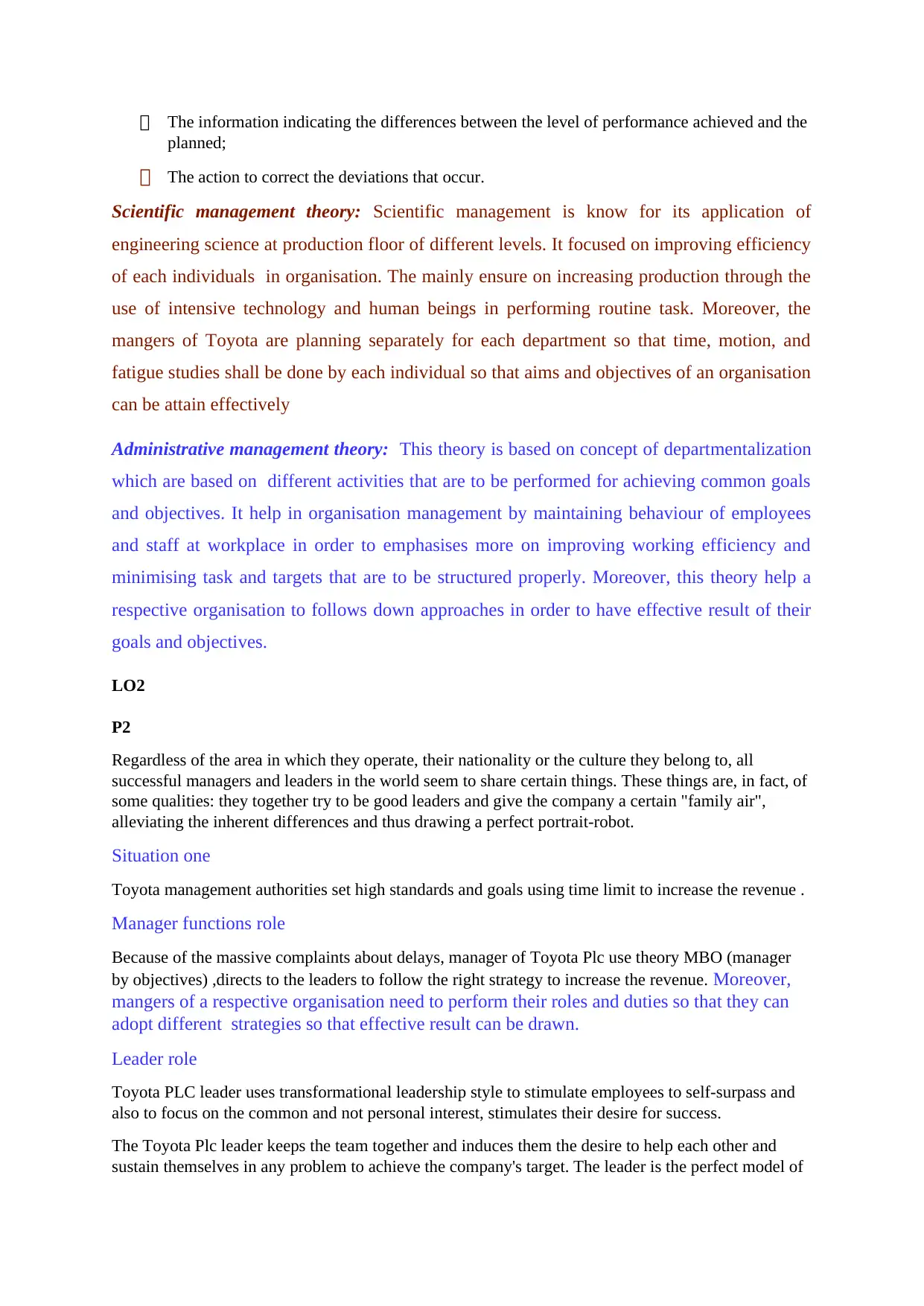
The information indicating the differences between the level of performance achieved and the
planned;
The action to correct the deviations that occur.
Scientific management theory: Scientific management is know for its application of
engineering science at production floor of different levels. It focused on improving efficiency
of each individuals in organisation. The mainly ensure on increasing production through the
use of intensive technology and human beings in performing routine task. Moreover, the
mangers of Toyota are planning separately for each department so that time, motion, and
fatigue studies shall be done by each individual so that aims and objectives of an organisation
can be attain effectively
Administrative management theory: This theory is based on concept of departmentalization
which are based on different activities that are to be performed for achieving common goals
and objectives. It help in organisation management by maintaining behaviour of employees
and staff at workplace in order to emphasises more on improving working efficiency and
minimising task and targets that are to be structured properly. Moreover, this theory help a
respective organisation to follows down approaches in order to have effective result of their
goals and objectives.
LO2
P2
Regardless of the area in which they operate, their nationality or the culture they belong to, all
successful managers and leaders in the world seem to share certain things. These things are, in fact, of
some qualities: they together try to be good leaders and give the company a certain "family air",
alleviating the inherent differences and thus drawing a perfect portrait-robot.
Situation one
Toyota management authorities set high standards and goals using time limit to increase the revenue .
Manager functions role
Because of the massive complaints about delays, manager of Toyota Plc use theory MBO (manager
by objectives) ,directs to the leaders to follow the right strategy to increase the revenue. Moreover,
mangers of a respective organisation need to perform their roles and duties so that they can
adopt different strategies so that effective result can be drawn.
Leader role
Toyota PLC leader uses transformational leadership style to stimulate employees to self-surpass and
also to focus on the common and not personal interest, stimulates their desire for success.
The Toyota Plc leader keeps the team together and induces them the desire to help each other and
sustain themselves in any problem to achieve the company's target. The leader is the perfect model of
planned;
The action to correct the deviations that occur.
Scientific management theory: Scientific management is know for its application of
engineering science at production floor of different levels. It focused on improving efficiency
of each individuals in organisation. The mainly ensure on increasing production through the
use of intensive technology and human beings in performing routine task. Moreover, the
mangers of Toyota are planning separately for each department so that time, motion, and
fatigue studies shall be done by each individual so that aims and objectives of an organisation
can be attain effectively
Administrative management theory: This theory is based on concept of departmentalization
which are based on different activities that are to be performed for achieving common goals
and objectives. It help in organisation management by maintaining behaviour of employees
and staff at workplace in order to emphasises more on improving working efficiency and
minimising task and targets that are to be structured properly. Moreover, this theory help a
respective organisation to follows down approaches in order to have effective result of their
goals and objectives.
LO2
P2
Regardless of the area in which they operate, their nationality or the culture they belong to, all
successful managers and leaders in the world seem to share certain things. These things are, in fact, of
some qualities: they together try to be good leaders and give the company a certain "family air",
alleviating the inherent differences and thus drawing a perfect portrait-robot.
Situation one
Toyota management authorities set high standards and goals using time limit to increase the revenue .
Manager functions role
Because of the massive complaints about delays, manager of Toyota Plc use theory MBO (manager
by objectives) ,directs to the leaders to follow the right strategy to increase the revenue. Moreover,
mangers of a respective organisation need to perform their roles and duties so that they can
adopt different strategies so that effective result can be drawn.
Leader role
Toyota PLC leader uses transformational leadership style to stimulate employees to self-surpass and
also to focus on the common and not personal interest, stimulates their desire for success.
The Toyota Plc leader keeps the team together and induces them the desire to help each other and
sustain themselves in any problem to achieve the company's target. The leader is the perfect model of
Paraphrase This Document
Need a fresh take? Get an instant paraphrase of this document with our AI Paraphraser
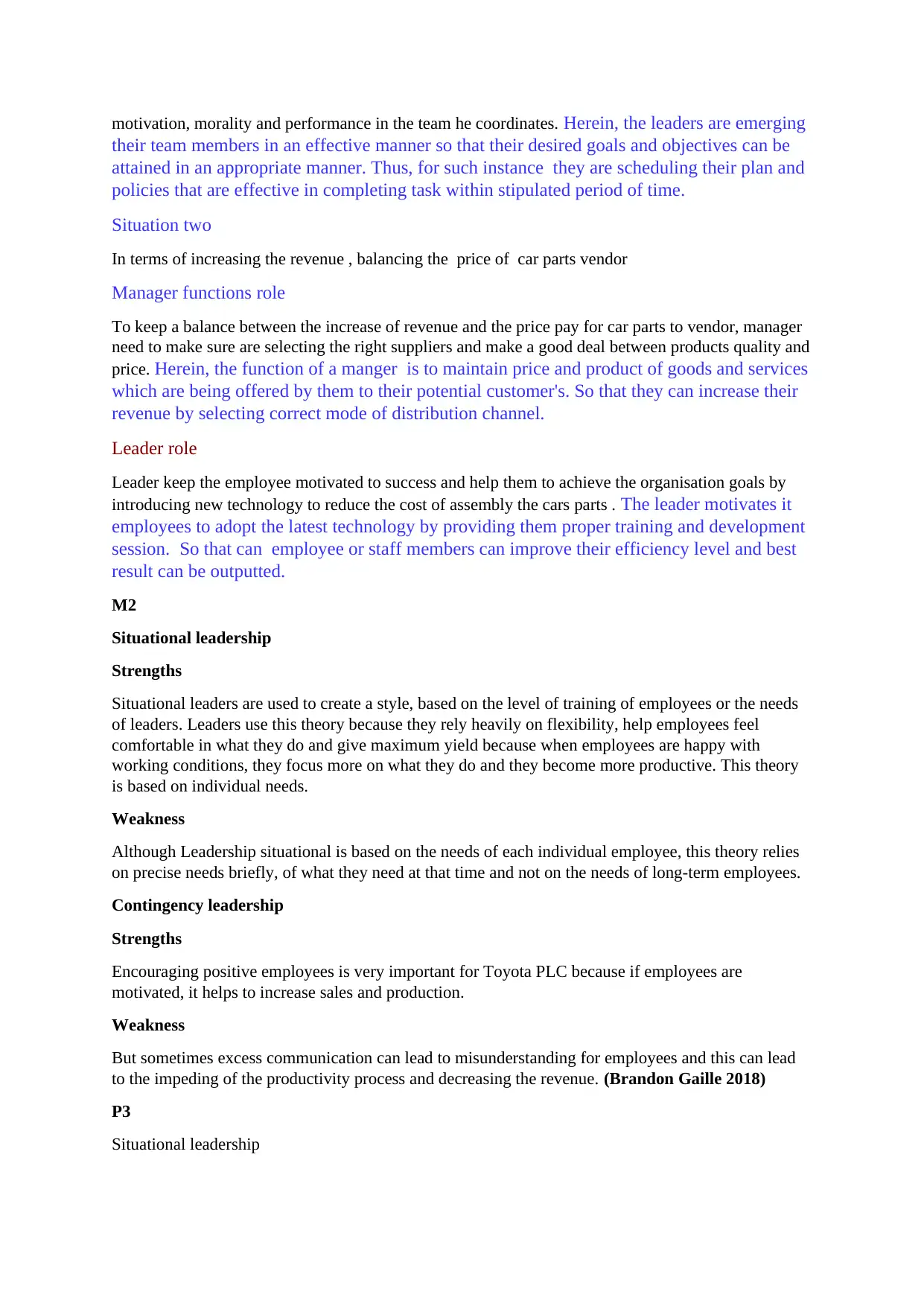
motivation, morality and performance in the team he coordinates. Herein, the leaders are emerging
their team members in an effective manner so that their desired goals and objectives can be
attained in an appropriate manner. Thus, for such instance they are scheduling their plan and
policies that are effective in completing task within stipulated period of time.
Situation two
In terms of increasing the revenue , balancing the price of car parts vendor
Manager functions role
To keep a balance between the increase of revenue and the price pay for car parts to vendor, manager
need to make sure are selecting the right suppliers and make a good deal between products quality and
price. Herein, the function of a manger is to maintain price and product of goods and services
which are being offered by them to their potential customer's. So that they can increase their
revenue by selecting correct mode of distribution channel.
Leader role
Leader keep the employee motivated to success and help them to achieve the organisation goals by
introducing new technology to reduce the cost of assembly the cars parts . The leader motivates it
employees to adopt the latest technology by providing them proper training and development
session. So that can employee or staff members can improve their efficiency level and best
result can be outputted.
M2
Situational leadership
Strengths
Situational leaders are used to create a style, based on the level of training of employees or the needs
of leaders. Leaders use this theory because they rely heavily on flexibility, help employees feel
comfortable in what they do and give maximum yield because when employees are happy with
working conditions, they focus more on what they do and they become more productive. This theory
is based on individual needs.
Weakness
Although Leadership situational is based on the needs of each individual employee, this theory relies
on precise needs briefly, of what they need at that time and not on the needs of long-term employees.
Contingency leadership
Strengths
Encouraging positive employees is very important for Toyota PLC because if employees are
motivated, it helps to increase sales and production.
Weakness
But sometimes excess communication can lead to misunderstanding for employees and this can lead
to the impeding of the productivity process and decreasing the revenue. (Brandon Gaille 2018)
P3
Situational leadership
their team members in an effective manner so that their desired goals and objectives can be
attained in an appropriate manner. Thus, for such instance they are scheduling their plan and
policies that are effective in completing task within stipulated period of time.
Situation two
In terms of increasing the revenue , balancing the price of car parts vendor
Manager functions role
To keep a balance between the increase of revenue and the price pay for car parts to vendor, manager
need to make sure are selecting the right suppliers and make a good deal between products quality and
price. Herein, the function of a manger is to maintain price and product of goods and services
which are being offered by them to their potential customer's. So that they can increase their
revenue by selecting correct mode of distribution channel.
Leader role
Leader keep the employee motivated to success and help them to achieve the organisation goals by
introducing new technology to reduce the cost of assembly the cars parts . The leader motivates it
employees to adopt the latest technology by providing them proper training and development
session. So that can employee or staff members can improve their efficiency level and best
result can be outputted.
M2
Situational leadership
Strengths
Situational leaders are used to create a style, based on the level of training of employees or the needs
of leaders. Leaders use this theory because they rely heavily on flexibility, help employees feel
comfortable in what they do and give maximum yield because when employees are happy with
working conditions, they focus more on what they do and they become more productive. This theory
is based on individual needs.
Weakness
Although Leadership situational is based on the needs of each individual employee, this theory relies
on precise needs briefly, of what they need at that time and not on the needs of long-term employees.
Contingency leadership
Strengths
Encouraging positive employees is very important for Toyota PLC because if employees are
motivated, it helps to increase sales and production.
Weakness
But sometimes excess communication can lead to misunderstanding for employees and this can lead
to the impeding of the productivity process and decreasing the revenue. (Brandon Gaille 2018)
P3
Situational leadership
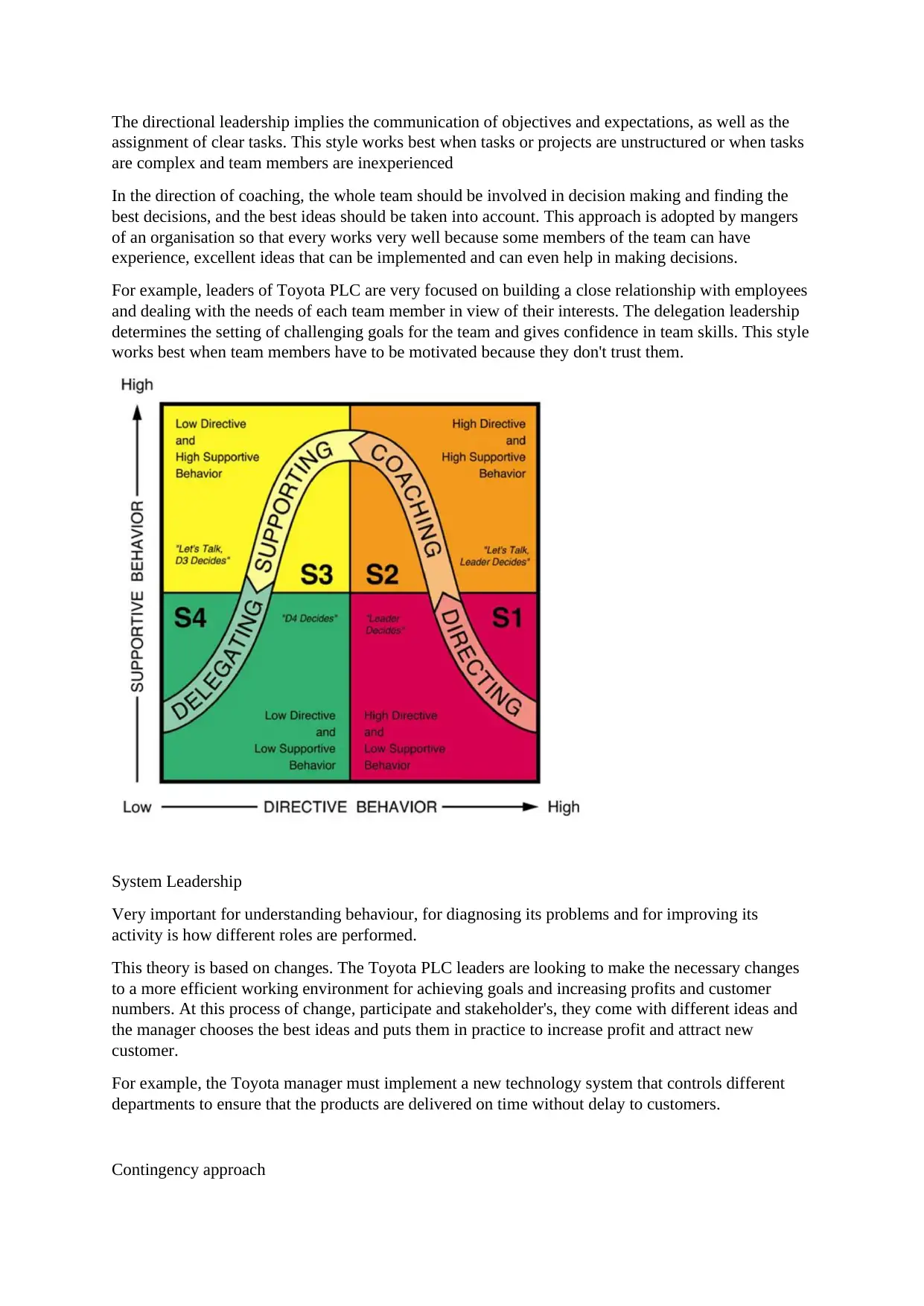
The directional leadership implies the communication of objectives and expectations, as well as the
assignment of clear tasks. This style works best when tasks or projects are unstructured or when tasks
are complex and team members are inexperienced
In the direction of coaching, the whole team should be involved in decision making and finding the
best decisions, and the best ideas should be taken into account. This approach is adopted by mangers
of an organisation so that every works very well because some members of the team can have
experience, excellent ideas that can be implemented and can even help in making decisions.
For example, leaders of Toyota PLC are very focused on building a close relationship with employees
and dealing with the needs of each team member in view of their interests. The delegation leadership
determines the setting of challenging goals for the team and gives confidence in team skills. This style
works best when team members have to be motivated because they don't trust them.
System Leadership
Very important for understanding behaviour, for diagnosing its problems and for improving its
activity is how different roles are performed.
This theory is based on changes. The Toyota PLC leaders are looking to make the necessary changes
to a more efficient working environment for achieving goals and increasing profits and customer
numbers. At this process of change, participate and stakeholder's, they come with different ideas and
the manager chooses the best ideas and puts them in practice to increase profit and attract new
customer.
For example, the Toyota manager must implement a new technology system that controls different
departments to ensure that the products are delivered on time without delay to customers.
Contingency approach
assignment of clear tasks. This style works best when tasks or projects are unstructured or when tasks
are complex and team members are inexperienced
In the direction of coaching, the whole team should be involved in decision making and finding the
best decisions, and the best ideas should be taken into account. This approach is adopted by mangers
of an organisation so that every works very well because some members of the team can have
experience, excellent ideas that can be implemented and can even help in making decisions.
For example, leaders of Toyota PLC are very focused on building a close relationship with employees
and dealing with the needs of each team member in view of their interests. The delegation leadership
determines the setting of challenging goals for the team and gives confidence in team skills. This style
works best when team members have to be motivated because they don't trust them.
System Leadership
Very important for understanding behaviour, for diagnosing its problems and for improving its
activity is how different roles are performed.
This theory is based on changes. The Toyota PLC leaders are looking to make the necessary changes
to a more efficient working environment for achieving goals and increasing profits and customer
numbers. At this process of change, participate and stakeholder's, they come with different ideas and
the manager chooses the best ideas and puts them in practice to increase profit and attract new
customer.
For example, the Toyota manager must implement a new technology system that controls different
departments to ensure that the products are delivered on time without delay to customers.
Contingency approach
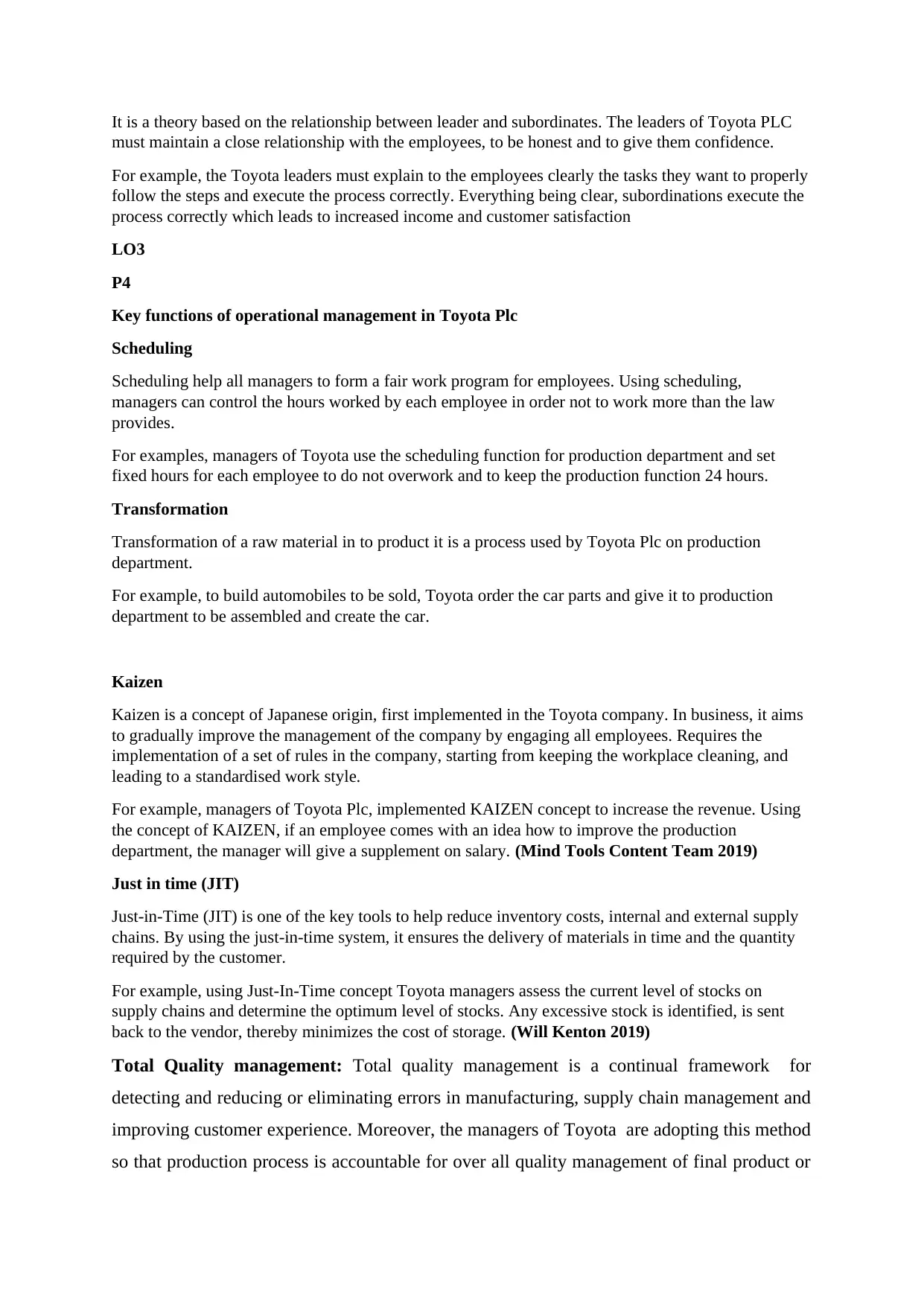
It is a theory based on the relationship between leader and subordinates. The leaders of Toyota PLC
must maintain a close relationship with the employees, to be honest and to give them confidence.
For example, the Toyota leaders must explain to the employees clearly the tasks they want to properly
follow the steps and execute the process correctly. Everything being clear, subordinations execute the
process correctly which leads to increased income and customer satisfaction
LO3
P4
Key functions of operational management in Toyota Plc
Scheduling
Scheduling help all managers to form a fair work program for employees. Using scheduling,
managers can control the hours worked by each employee in order not to work more than the law
provides.
For examples, managers of Toyota use the scheduling function for production department and set
fixed hours for each employee to do not overwork and to keep the production function 24 hours.
Transformation
Transformation of a raw material in to product it is a process used by Toyota Plc on production
department.
For example, to build automobiles to be sold, Toyota order the car parts and give it to production
department to be assembled and create the car.
Kaizen
Kaizen is a concept of Japanese origin, first implemented in the Toyota company. In business, it aims
to gradually improve the management of the company by engaging all employees. Requires the
implementation of a set of rules in the company, starting from keeping the workplace cleaning, and
leading to a standardised work style.
For example, managers of Toyota Plc, implemented KAIZEN concept to increase the revenue. Using
the concept of KAIZEN, if an employee comes with an idea how to improve the production
department, the manager will give a supplement on salary. (Mind Tools Content Team 2019)
Just in time (JIT)
Just-in-Time (JIT) is one of the key tools to help reduce inventory costs, internal and external supply
chains. By using the just-in-time system, it ensures the delivery of materials in time and the quantity
required by the customer.
For example, using Just-In-Time concept Toyota managers assess the current level of stocks on
supply chains and determine the optimum level of stocks. Any excessive stock is identified, is sent
back to the vendor, thereby minimizes the cost of storage. (Will Kenton 2019)
Total Quality management: Total quality management is a continual framework for
detecting and reducing or eliminating errors in manufacturing, supply chain management and
improving customer experience. Moreover, the managers of Toyota are adopting this method
so that production process is accountable for over all quality management of final product or
must maintain a close relationship with the employees, to be honest and to give them confidence.
For example, the Toyota leaders must explain to the employees clearly the tasks they want to properly
follow the steps and execute the process correctly. Everything being clear, subordinations execute the
process correctly which leads to increased income and customer satisfaction
LO3
P4
Key functions of operational management in Toyota Plc
Scheduling
Scheduling help all managers to form a fair work program for employees. Using scheduling,
managers can control the hours worked by each employee in order not to work more than the law
provides.
For examples, managers of Toyota use the scheduling function for production department and set
fixed hours for each employee to do not overwork and to keep the production function 24 hours.
Transformation
Transformation of a raw material in to product it is a process used by Toyota Plc on production
department.
For example, to build automobiles to be sold, Toyota order the car parts and give it to production
department to be assembled and create the car.
Kaizen
Kaizen is a concept of Japanese origin, first implemented in the Toyota company. In business, it aims
to gradually improve the management of the company by engaging all employees. Requires the
implementation of a set of rules in the company, starting from keeping the workplace cleaning, and
leading to a standardised work style.
For example, managers of Toyota Plc, implemented KAIZEN concept to increase the revenue. Using
the concept of KAIZEN, if an employee comes with an idea how to improve the production
department, the manager will give a supplement on salary. (Mind Tools Content Team 2019)
Just in time (JIT)
Just-in-Time (JIT) is one of the key tools to help reduce inventory costs, internal and external supply
chains. By using the just-in-time system, it ensures the delivery of materials in time and the quantity
required by the customer.
For example, using Just-In-Time concept Toyota managers assess the current level of stocks on
supply chains and determine the optimum level of stocks. Any excessive stock is identified, is sent
back to the vendor, thereby minimizes the cost of storage. (Will Kenton 2019)
Total Quality management: Total quality management is a continual framework for
detecting and reducing or eliminating errors in manufacturing, supply chain management and
improving customer experience. Moreover, the managers of Toyota are adopting this method
so that production process is accountable for over all quality management of final product or
Secure Best Marks with AI Grader
Need help grading? Try our AI Grader for instant feedback on your assignments.

service. This is a structured approach to over all organisation management that aims in
improving quality of organisation output including foods and services through continual
improvement of internal practices.
P5
Importance of operation management: Operation management is process that involves
planning, organising, managing, controlling and supervising the production and
manufacturing process. It play's a vital role in completion of a project. It involves in
management of every industry or business irrespective of nature of operation. It help in
performing daily activities so that maximum utilization of resources can be adopted.
Moreover, it helps in improving overall productivity as it gives major efficiency to mangers
of an organisation as well as employees so that best possible ways can be determined
achieving goals and objectives.
Furthermore, it will going to add value to an organisation if productivity and profitability of
business is increasing day by day by satisfying customer as per their need and preferences.
Six Sigma and Lean production
Lean production and Six Sigma are both disciplines to permanently remedy the processes within a
company, but they differ in setting the primordial objectives and the lean approaches is a discipline in
which the objective is to eliminate The waste and efficiency of the growth process by focusing on
speed and cost optimization. Lazzari Z (2018)
Lean production , ensures the stability of the process by reducing losses and simplifying activities that
provide value to the customer.
If Lean production ensures the stability of the processes and their deployment in a continuous stream,
the Six Sigma management methodology focuses on improving quality by decreasing variability by
resorting to various statistical and qualitative tools.
While in Lean production, Kaizen-type events, value flow mapping, workload balancing and waste
analysis are used, the Six SIGMA methodology will address the DMAIC model (define, measure,
analyse, improve, control) in to reduce the variability of processes through a deeper orientation
towards the customer. This will improve the prospect of understanding the critical points of each
product or service offered and by making decisions based on the available values and the
circumstances envisaged.
For example, managers of Toyota PLC, use Six Sigma approach to increases consumer satisfaction
and meet their expectation, to increase the revenue and reduce the cost.
For example ,leaders of Toyota are using Six Sigma approach to satisfy employee needs and persuade
them to work hard for company goals
improving quality of organisation output including foods and services through continual
improvement of internal practices.
P5
Importance of operation management: Operation management is process that involves
planning, organising, managing, controlling and supervising the production and
manufacturing process. It play's a vital role in completion of a project. It involves in
management of every industry or business irrespective of nature of operation. It help in
performing daily activities so that maximum utilization of resources can be adopted.
Moreover, it helps in improving overall productivity as it gives major efficiency to mangers
of an organisation as well as employees so that best possible ways can be determined
achieving goals and objectives.
Furthermore, it will going to add value to an organisation if productivity and profitability of
business is increasing day by day by satisfying customer as per their need and preferences.
Six Sigma and Lean production
Lean production and Six Sigma are both disciplines to permanently remedy the processes within a
company, but they differ in setting the primordial objectives and the lean approaches is a discipline in
which the objective is to eliminate The waste and efficiency of the growth process by focusing on
speed and cost optimization. Lazzari Z (2018)
Lean production , ensures the stability of the process by reducing losses and simplifying activities that
provide value to the customer.
If Lean production ensures the stability of the processes and their deployment in a continuous stream,
the Six Sigma management methodology focuses on improving quality by decreasing variability by
resorting to various statistical and qualitative tools.
While in Lean production, Kaizen-type events, value flow mapping, workload balancing and waste
analysis are used, the Six SIGMA methodology will address the DMAIC model (define, measure,
analyse, improve, control) in to reduce the variability of processes through a deeper orientation
towards the customer. This will improve the prospect of understanding the critical points of each
product or service offered and by making decisions based on the available values and the
circumstances envisaged.
For example, managers of Toyota PLC, use Six Sigma approach to increases consumer satisfaction
and meet their expectation, to increase the revenue and reduce the cost.
For example ,leaders of Toyota are using Six Sigma approach to satisfy employee needs and persuade
them to work hard for company goals
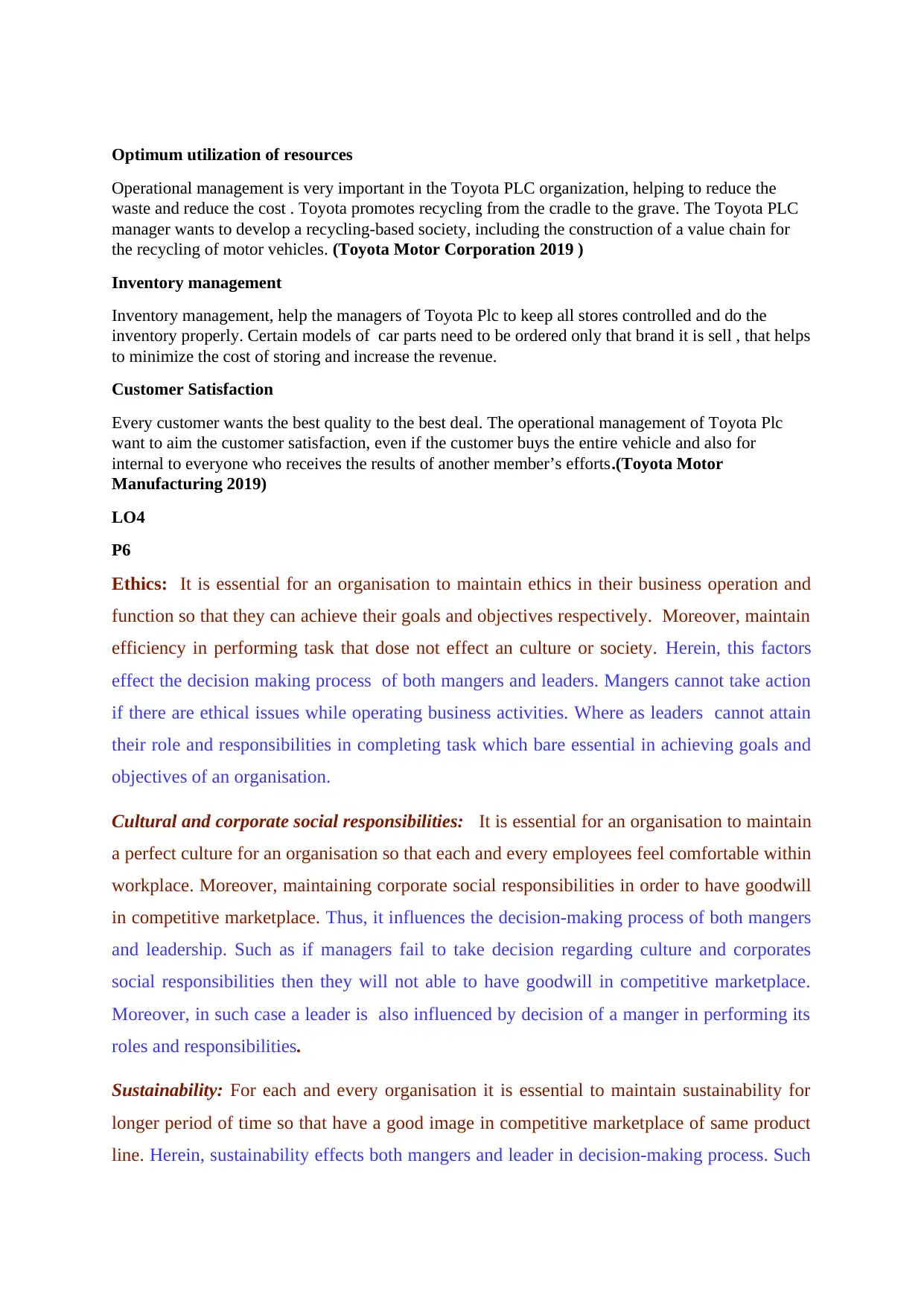
Optimum utilization of resources
Operational management is very important in the Toyota PLC organization, helping to reduce the
waste and reduce the cost . Toyota promotes recycling from the cradle to the grave. The Toyota PLC
manager wants to develop a recycling-based society, including the construction of a value chain for
the recycling of motor vehicles. (Toyota Motor Corporation 2019 )
Inventory management
Inventory management, help the managers of Toyota Plc to keep all stores controlled and do the
inventory properly. Certain models of car parts need to be ordered only that brand it is sell , that helps
to minimize the cost of storing and increase the revenue.
Customer Satisfaction
Every customer wants the best quality to the best deal. The operational management of Toyota Plc
want to aim the customer satisfaction, even if the customer buys the entire vehicle and also for
internal to everyone who receives the results of another member’s efforts.(Toyota Motor
Manufacturing 2019)
LO4
P6
Ethics: It is essential for an organisation to maintain ethics in their business operation and
function so that they can achieve their goals and objectives respectively. Moreover, maintain
efficiency in performing task that dose not effect an culture or society. Herein, this factors
effect the decision making process of both mangers and leaders. Mangers cannot take action
if there are ethical issues while operating business activities. Where as leaders cannot attain
their role and responsibilities in completing task which bare essential in achieving goals and
objectives of an organisation.
Cultural and corporate social responsibilities: It is essential for an organisation to maintain
a perfect culture for an organisation so that each and every employees feel comfortable within
workplace. Moreover, maintaining corporate social responsibilities in order to have goodwill
in competitive marketplace. Thus, it influences the decision-making process of both mangers
and leadership. Such as if managers fail to take decision regarding culture and corporates
social responsibilities then they will not able to have goodwill in competitive marketplace.
Moreover, in such case a leader is also influenced by decision of a manger in performing its
roles and responsibilities.
Sustainability: For each and every organisation it is essential to maintain sustainability for
longer period of time so that have a good image in competitive marketplace of same product
line. Herein, sustainability effects both mangers and leader in decision-making process. Such
Operational management is very important in the Toyota PLC organization, helping to reduce the
waste and reduce the cost . Toyota promotes recycling from the cradle to the grave. The Toyota PLC
manager wants to develop a recycling-based society, including the construction of a value chain for
the recycling of motor vehicles. (Toyota Motor Corporation 2019 )
Inventory management
Inventory management, help the managers of Toyota Plc to keep all stores controlled and do the
inventory properly. Certain models of car parts need to be ordered only that brand it is sell , that helps
to minimize the cost of storing and increase the revenue.
Customer Satisfaction
Every customer wants the best quality to the best deal. The operational management of Toyota Plc
want to aim the customer satisfaction, even if the customer buys the entire vehicle and also for
internal to everyone who receives the results of another member’s efforts.(Toyota Motor
Manufacturing 2019)
LO4
P6
Ethics: It is essential for an organisation to maintain ethics in their business operation and
function so that they can achieve their goals and objectives respectively. Moreover, maintain
efficiency in performing task that dose not effect an culture or society. Herein, this factors
effect the decision making process of both mangers and leaders. Mangers cannot take action
if there are ethical issues while operating business activities. Where as leaders cannot attain
their role and responsibilities in completing task which bare essential in achieving goals and
objectives of an organisation.
Cultural and corporate social responsibilities: It is essential for an organisation to maintain
a perfect culture for an organisation so that each and every employees feel comfortable within
workplace. Moreover, maintaining corporate social responsibilities in order to have goodwill
in competitive marketplace. Thus, it influences the decision-making process of both mangers
and leadership. Such as if managers fail to take decision regarding culture and corporates
social responsibilities then they will not able to have goodwill in competitive marketplace.
Moreover, in such case a leader is also influenced by decision of a manger in performing its
roles and responsibilities.
Sustainability: For each and every organisation it is essential to maintain sustainability for
longer period of time so that have a good image in competitive marketplace of same product
line. Herein, sustainability effects both mangers and leader in decision-making process. Such
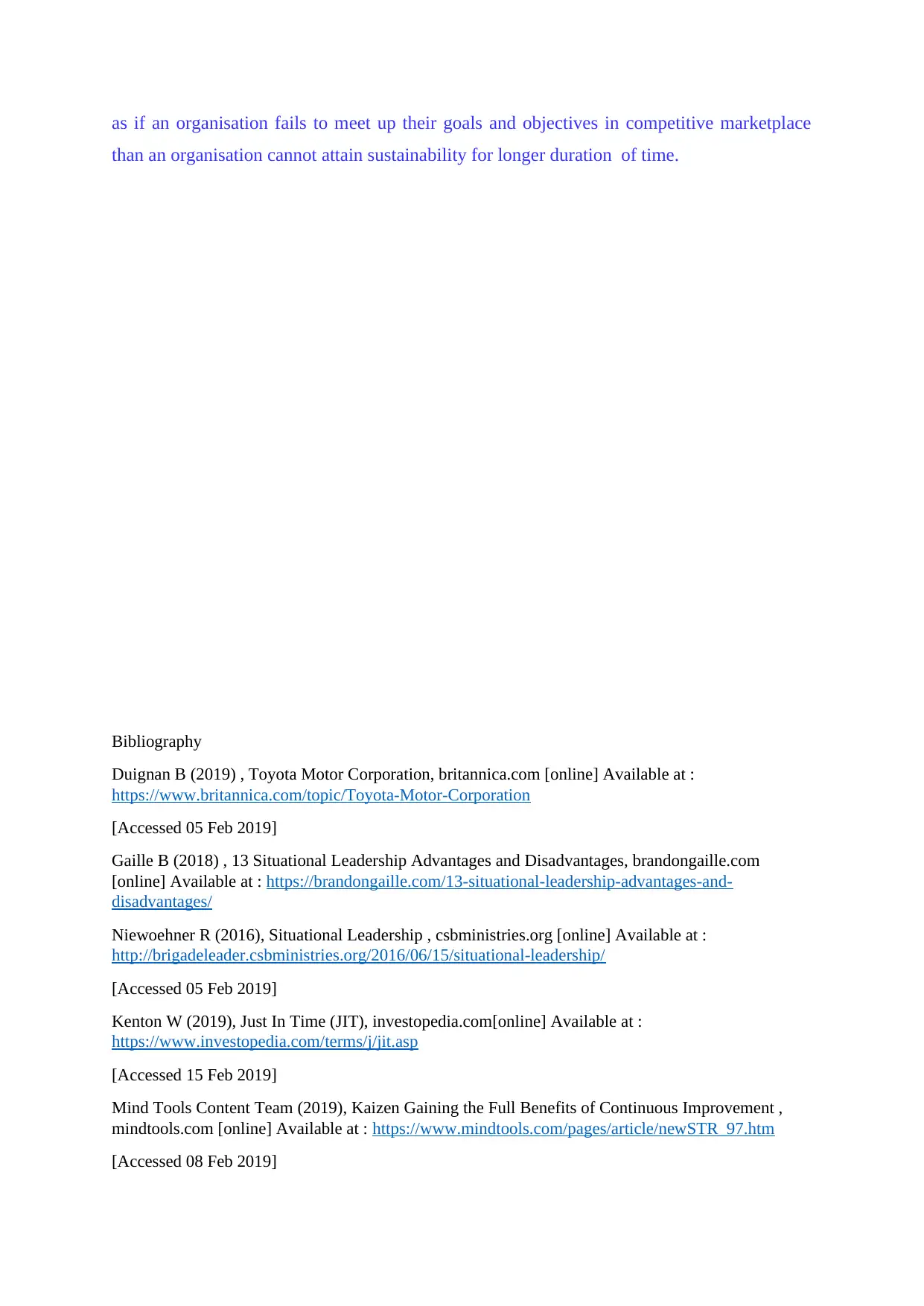
as if an organisation fails to meet up their goals and objectives in competitive marketplace
than an organisation cannot attain sustainability for longer duration of time.
Bibliography
Duignan B (2019) , Toyota Motor Corporation, britannica.com [online] Available at :
https://www.britannica.com/topic/Toyota-Motor-Corporation
[Accessed 05 Feb 2019]
Gaille B (2018) , 13 Situational Leadership Advantages and Disadvantages, brandongaille.com
[online] Available at : https://brandongaille.com/13-situational-leadership-advantages-and-
disadvantages/
Niewoehner R (2016), Situational Leadership , csbministries.org [online] Available at :
http://brigadeleader.csbministries.org/2016/06/15/situational-leadership/
[Accessed 05 Feb 2019]
Kenton W (2019), Just In Time (JIT), investopedia.com[online] Available at :
https://www.investopedia.com/terms/j/jit.asp
[Accessed 15 Feb 2019]
Mind Tools Content Team (2019), Kaizen Gaining the Full Benefits of Continuous Improvement ,
mindtools.com [online] Available at : https://www.mindtools.com/pages/article/newSTR_97.htm
[Accessed 08 Feb 2019]
than an organisation cannot attain sustainability for longer duration of time.
Bibliography
Duignan B (2019) , Toyota Motor Corporation, britannica.com [online] Available at :
https://www.britannica.com/topic/Toyota-Motor-Corporation
[Accessed 05 Feb 2019]
Gaille B (2018) , 13 Situational Leadership Advantages and Disadvantages, brandongaille.com
[online] Available at : https://brandongaille.com/13-situational-leadership-advantages-and-
disadvantages/
Niewoehner R (2016), Situational Leadership , csbministries.org [online] Available at :
http://brigadeleader.csbministries.org/2016/06/15/situational-leadership/
[Accessed 05 Feb 2019]
Kenton W (2019), Just In Time (JIT), investopedia.com[online] Available at :
https://www.investopedia.com/terms/j/jit.asp
[Accessed 15 Feb 2019]
Mind Tools Content Team (2019), Kaizen Gaining the Full Benefits of Continuous Improvement ,
mindtools.com [online] Available at : https://www.mindtools.com/pages/article/newSTR_97.htm
[Accessed 08 Feb 2019]
Paraphrase This Document
Need a fresh take? Get an instant paraphrase of this document with our AI Paraphraser
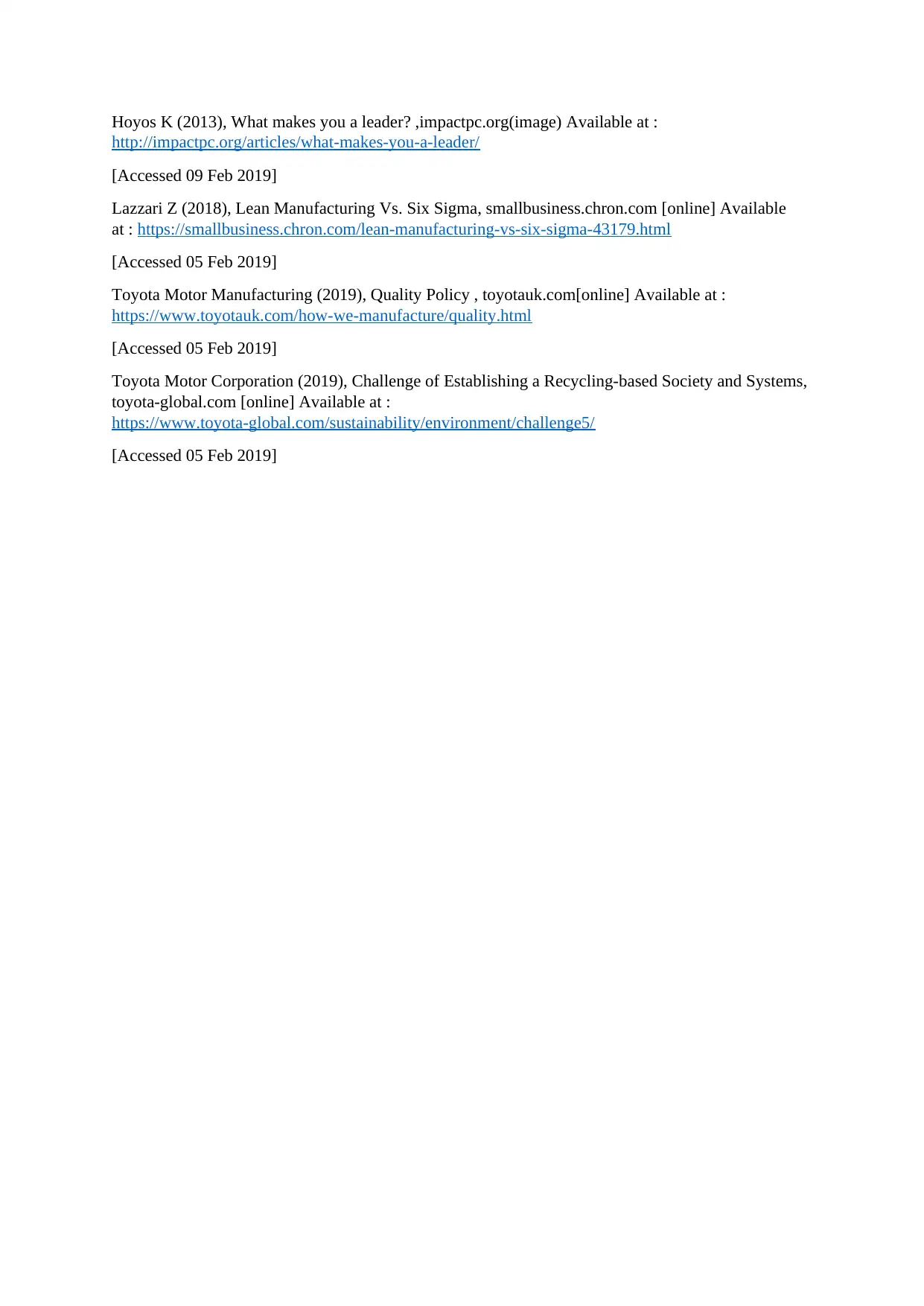
Hoyos K (2013), What makes you a leader? ,impactpc.org(image) Available at :
http://impactpc.org/articles/what-makes-you-a-leader/
[Accessed 09 Feb 2019]
Lazzari Z (2018), Lean Manufacturing Vs. Six Sigma, smallbusiness.chron.com [online] Available
at : https://smallbusiness.chron.com/lean-manufacturing-vs-six-sigma-43179.html
[Accessed 05 Feb 2019]
Toyota Motor Manufacturing (2019), Quality Policy , toyotauk.com[online] Available at :
https://www.toyotauk.com/how-we-manufacture/quality.html
[Accessed 05 Feb 2019]
Toyota Motor Corporation (2019), Challenge of Establishing a Recycling-based Society and Systems,
toyota-global.com [online] Available at :
https://www.toyota-global.com/sustainability/environment/challenge5/
[Accessed 05 Feb 2019]
http://impactpc.org/articles/what-makes-you-a-leader/
[Accessed 09 Feb 2019]
Lazzari Z (2018), Lean Manufacturing Vs. Six Sigma, smallbusiness.chron.com [online] Available
at : https://smallbusiness.chron.com/lean-manufacturing-vs-six-sigma-43179.html
[Accessed 05 Feb 2019]
Toyota Motor Manufacturing (2019), Quality Policy , toyotauk.com[online] Available at :
https://www.toyotauk.com/how-we-manufacture/quality.html
[Accessed 05 Feb 2019]
Toyota Motor Corporation (2019), Challenge of Establishing a Recycling-based Society and Systems,
toyota-global.com [online] Available at :
https://www.toyota-global.com/sustainability/environment/challenge5/
[Accessed 05 Feb 2019]
1 out of 14
Related Documents
Your All-in-One AI-Powered Toolkit for Academic Success.
+13062052269
info@desklib.com
Available 24*7 on WhatsApp / Email
![[object Object]](/_next/static/media/star-bottom.7253800d.svg)
Unlock your academic potential
© 2024 | Zucol Services PVT LTD | All rights reserved.





